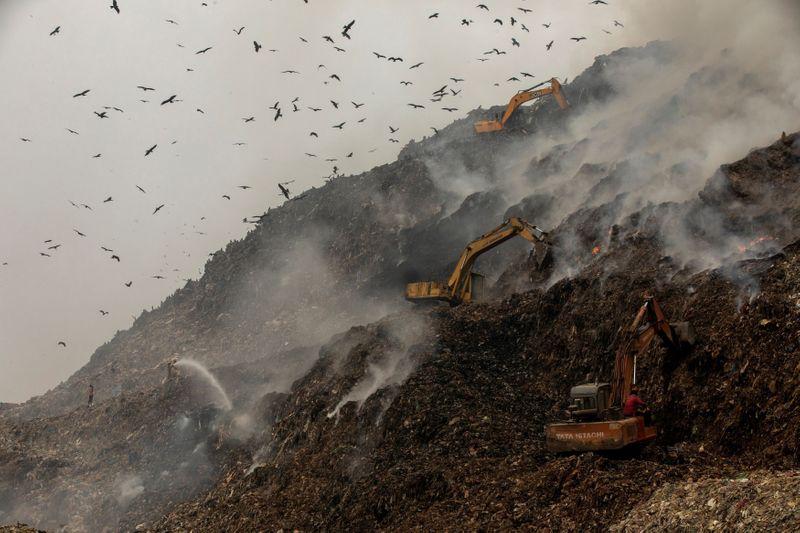Why Mitigating Methane Emissions Matters…
Sep 3, 2023 | Pratirodh Bureau
The deadlines for removing two landfills – Bhalswa (March 2024) and Okhla (December 2023) – have been missed and it appears the date to clear out the Ghazipur mound (December 2024) will also pass by without any action. And now, even as the bureaucracy coins terms such as “legacy waste”, new deadlines have been set to rid the Indian capital of the ‘ugly’ features (Representational Image)
- Methane (CH4) is a powerful greenhouse gas. In the first 20 years after release, methane is 86 times more powerful than carbon dioxide in trapping heat.
- The three main sources of methane emissions are waste and landfill sites, fossil fuels and natural gas leaks, and agriculture.
- While it is considered second to carbon dioxide as a greenhouse gas, curbing methane emissions is the fastest way to slow global warming.
Methane or CH4, is a powerful greenhouse gas. It forms only 0.00017% of the atmosphere, but it is crucial in keeping the earth warm and habitable. Excess methane, however, is one of the most dangerous causes of global warming.
In the first 20 years after release, methane is 86 times more powerful than carbon dioxide in trapping heat. In fact, it has been responsible for 40% of global warming, since the Industrial Revolution.
What Are The Main Sources Of Methane Emissions?
More than half of the global methane emissions stem from human activities in three sectors: agriculture (40%), fossil fuels (35% of human-caused emissions) and waste and landfills (20%).
In the third place are the landfills. Piles of garbage produce methane when they rot. Then, heatwaves, cigarette butts and other fire sources lead to the infamous landfill fires.
Methane-monitoring satellites that zoom in on sources of the climate-warming gas show that landfills contributed to more than 25 percent of methane emissions in Mumbai and six percent in Delhi. In Pune, isotopic studies, which rely on methane’s atomic makeup, point to significant landfill emissions of methane and a potential natural gas leak.
In the second place are leakages from oil and gas companies and other industrial operations. Burning natural gas produces much less carbon dioxide, than burning oil or coal. Along the way to the burner however, some natural gas escapes, which is mainly methane.
And the biggest methane emitter is the agriculture sector. Rice cultivation, enteric fermentation in cattle and crop residue burning are some of the sources of methane emission in agriculture.
Indu Murthy, sector head for climate and environmental sustainability at CSTEP, a think tank based in Bengaluru, elaborates, “When we talk about agricultural methane emissions, it’s primarily from rice cultivation. As you know, in rice cultivation, there is a lot of standing water that’s left after you inundate the crop. That’s the traditional way of growing rice. What happens when you do that is there is something called anaerobic respiration. You let water stay for a long time and the oxygen levels get depleted. And then there is methane and nitrous oxide emissions that emanate as a result of that.”
How Does Methane Impact Human Health?
Increased methane emissions are responsible for half of the observed rise in tropospheric ozone or ground-level ozone, a harmful air pollutant. It creates smog, thereby worsening bronchitis, triggering asthma and permanently damaging lung tissue. Exposure to ground-level ozone has resulted in an estimated one million premature deaths each year.
India is one of the top five emitters of methane. It also has dangerously high levels of tropospheric ozone.
What Are The Solutions To Curb Methane Emissions?
In November 2021, nearly 100 countries signed the Global Methane Pledge at the climate conference COP26. They made a promise to curb methane emissions by 2030. India, however, did not sign the pledge.
Murthy, who is also part of the committee that maintains the national inventory of greenhouse gases, explains why. “When you talk about agriculture in India, it’s a climate-sensitive sector. Secondly, much of the population that is dependent on agriculture are small and marginal farmers, and almost 51% of Indian agriculture is rain-fed agriculture. We could probably call it survival emissions because people are producing food for subsistence,” she says.
She argues that it would not really be fair to burden a farmer who is fighting for subsistence, to commit to methane mitigation targets.
However, India’s scientists and policymakers are trying different ways to reduce methane emissions. From new varieties of rice that require less water, to better quality cattle feed that can reduce methane emissions from cows, and other technological developments for managing landfills and methane leaks in industries, to even coming up with an accurate measurement for methane emissions, there are regular experiments and improvements. But the process has been slow and expensive.
(Published under Creative Commons from Mongabay-India. Read the original article here)
